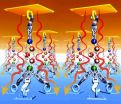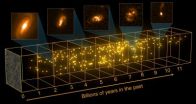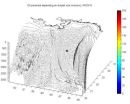(Press-News.org) Troy, N.Y. – A team of interdisciplinary researchers at Rensselaer Polytechnic Institute has developed a new method for significantly increasing the heat transfer rate across two different materials. Results of the team's study, published in the journal Nature Materials, could enable new advances in cooling computer chips and lighting-emitting diode (LED) devices, collecting solar power, harvesting waste heat, and other applications.
By sandwiching a layer of ultrathin "nanoglue" between copper and silica, the research team demonstrated a four-fold increase in thermal conductance at the interface between the two materials. Less than a nanometer—or one billionth of a meter—thick, the nanoglue is a layer of molecules that form strong links with the copper (a metal) and the silica (a ceramic), which otherwise would not stick together well. This kind of nanomolecular locking improves adhesion, and also helps to sync up the vibrations of atoms that make up the two materials which, in turn, facilitates more efficient transport of heat particles called phonons. Beyond copper and silica, the research team has demonstrated their approach works with other metal-ceramic interfaces.
Heat transfer is a critical aspect of many different technologies. As computer chips grow smaller and more complex, manufacturers are constantly in search of new and better means for removing excess heat from semiconductor devices to boost reliability and performance. With photovoltaic devices, for example, better heat transfer leads to more efficient conversion of sunlight to electrical power. LED makers are also looking for ways to increase efficiency by reducing the percentage of input power lost as heat. Ganapati Ramanath, professor in the Department of Materials Science and Engineering at Rensselaer, who led the new study, said the ability to enhance and optimize interfacial thermal conductance should lead to new innovations in these and other applications.
"Interfaces between different materials are often heat-flow bottlenecks due to stifled phonon transport. Inserting a third material usually only makes things worse because of an additional interface created," Ramanath said. "However, our method of introducing an ultrathin nanolayer of organic molecules that strongly bond with both the materials at the interface gives rise to multi-fold increases in interfacial thermal conductance, contrary to poor heat conduction seen at inorganic-organic interfaces. This method to tune thermal conductance by controlling adhesion using an organic nanolayer works for multiple materials systems, and offers a new means for atomic- and molecular-level manipulation of multiple properties at different types of materials interfaces. Also, it's cool to be able to do this rather unobtrusively by the simple method of self-assembly of a single layer of molecules."
Results of the new study, titled "Bonding-induced thermal conductance enhancement at inorganic heterointerfaces using nanomolecular monolayers," were published online recently by Nature Materials, and will appear in an upcoming print edition of the journal. The study may be viewed online at: http://go.nature.com/3LLeYP
The research team used a combination of experiments and theory to validate their findings.
"Our study establishes the correlation between interfacial bond strength and thermal conductance, which serves to underpin new theoretical descriptions and open up new ways to control interfacial heat transfer," said co-author Pawel Keblinski, professor in the Department of Materials Science and Engineering at Rensselaer.
"It is truly remarkable that a single molecular layer can bring about such a large improvement in the thermal properties of interfaces by forming strong interfacial bonds. This would be useful for controlling heat transport for many applications in electronics, lighting, and energy generation," said co-author Masashi Yamaguchi, associate professor in the Department of Physics, Applied Physics, and Astronomy at Rensselaer.
This study was funded with support from the National Science Foundation (NSF).
"The overarching goal of Professor Ramanath's NSF-sponsored research is to elucidate, using first-principles-based models, the effects of molecular chemistry, chemical environment, interface topography, and thermo-mechanical cycling on the thermal conductance of metal-ceramic interfaces modified with molecular nanolayers," said Clark V. Cooper, senior advisor for science at the NSF Directorate for Mathematical and Physical Sciences, who formerly held the post of program director for Materials and Surface Engineering. "Consistent with NSF's mission, the focus of his research is to advance fundamental science, but the potential societal benefits of the research are enormous."
"This is a fascinating example of the interplay between the physical, chemical, and mechanical properties working in unison at the nanoscale to determine the heat transport characteristics at dissimilar metal-ceramic interfaces," said Anupama B. Kaul, a program director for the Division of Electrical, Communications, and Cyber Systems at the NSF Directorate for Engineering. "The fact that the organic nanomolecular layer is just a monolayer in thickness and yet has such an important influence on the thermal characteristics is truly remarkable. Dr. Ramanath's results should be particularly valuable in nanoelectronics where heat management due to shrinking device dimensions continues to be an area of active research."
INFORMATION:
Along with Ramanath, Keblinski, and Yamaguchi, co-authors of the paper are Rensselaer materials science graduate students Peter O'Brien, Sergei Shenogin, and Philippe K. Chow; Rensselaer physics graduate student Jianxiun Liu; and Danielle Laurencin and P. Hubert Mutin of the Institut Charles Gerhardt Montpellier and Université Montpellier in France.
For more information on Ramanath and his nanomaterials research at Rensselaer, visit:
Nature Materials Study: Quick-Cooking Nanomaterials in a $40 Microwave Oven To Make Tomorrow's Solid-State Air Conditioners and Refrigerators
http://news.rpi.edu/update.do?artcenterkey=2971
Inexpensive "Nanoglue" Can Bond Nearly Anything Together
http://news.rpi.edu/update.do?artcenterkey=2154
"Nanosculpture" Could Enable New Types of Heat Pumps and Energy Converters
http://news.rpi.edu/update.do?artcenterkey=2471
Strengthening Fluids With Nanoparticles
http://news.rpi.edu/update.do?artcenterkey=2402
Faculty Home Page
http://homepages.rpi.edu/~ganapr/
Contact
Michael Mullaney
Rensselaer Polytechnic Institute
Troy, NY
518-276-6161
mullam@rpi.edu
www.rpi.edu/news
Visit the Rensselaer research and discovery blog: http://approach.rpi.edu
Follow us on Twitter: www.twitter.com/RPInews
Nature Materials study: Boosting heat transfer with nanoglue
Interdisciplinary study from Rensselaer Polytechnic Institute demonstrates new method for significantly increasing heat transfer rate across 2 different materials
2012-12-04
ELSE PRESS RELEASES FROM THIS DATE:
Fish oil helps heal bed sores of the critically ill
2012-12-04
Chock-full of Omega-3 fatty acids and antioxidants, fish oil can help lower blood pressure, reduce inflammation in the skin and joints, and promote healthy fetal development. Now a Tel Aviv University researcher has found that it has a positive effect on bedsores, too.
A common problem in critically ill patients, bedsores result from constant pressure on the skin and underlying tissue due to prolonged sitting or lying down. Painful and prone to infection, the pressure ulcers need to be healed, says Prof. Pierre Singer of the Sackler Faculty of Medicine. With Ph.D. candidate ...
Understanding anger, overcoming anxiety
2012-12-04
Montreal, December 4, 2012 – Anger is a powerful emotion with serious health consequences. A new study from Concordia University shows that for millions of individuals around the world who suffer from Generalized Anxiety Disorder (GAD), anger is more than an emotion; it's an agent that exacerbates their illness.
Concordia graduate student Sonya Deschênes investigated the subject after conducting a literature review for her PhD research, supervised by psychology professor Michel Dugas. While some of the studies she came across showed that anger and anxiety were linked, ...
Sunshine, biofuel and the tides, oh my!
2012-12-04
SAN FRANCISCO - Scientists from the Department of Energy's Pacific Northwest National Laboratory will present a variety of alternative energy-related research at the 2012 American Geophysical Union Fall Meeting, which runs Monday, Dec. 3 through Friday, Dec. 7 at the Moscone Convention Center in San Francisco. Topics to be discussed include improving solar power forecasting, measuring the resources needed to grow algae for biofuel and predicting the environmental impacts of ocean energy. Summaries of some of PNNL's noteworthy presentations are below.
Forecasting clouds ...
Herschel and Keck take census of the invisible Universe
2012-12-04
By combining the observing powers of ESA's Herschel space observatory and the ground-based Keck telescopes, astronomers have characterised hundreds of previously unseen starburst galaxies, revealing extraordinary high star-formation rates across the history of the Universe.
Starburst galaxies give birth to hundreds of solar masses' worth of stars each year in short-lived but intense events.
By comparison, our own Milky Way Galaxy on average produces the equivalent of only one Sun-like star per year.
Starburst galaxies generate so much starlight that they should outshine ...
Overprescribing of opioids impacts patient safety and public health
2012-12-04
A Viewpoint article published recently in the Journal of the American Medical Association suggests that the clinical practice of prescribing amphetamines, opioids, and benzodiazepines to treat chronic pain may be contributing to the increase in fatal drug overdoses and the likelihood that those drugs will be diverted to the illegal market. "Rethinking Opioid Prescribing to Protect Patient Safety and Public Health" was authored by Johns Hopkins Bloomberg School of Public Health researchers G. Caleb Alexander, MD, MS, and Daniel Webster, ScD, MPH, and Stefan P. Kruszewski, ...
Targeting neurotransmitter may help treat gastrointestinal conditions
2012-12-04
HERSHEY, Pa. -- Selective targeting of the neurotransmitter that differentially affects brain cells that control the two distinct functions of the pancreas may allow for new medication therapies for conditions like diabetes, dyspepsia and gastro-esophageal reflux, according to Penn State College of Medicine researchers.
"This study differs from what's been reported previously about brain neurons that control the gastrointestinal tract," said R. Alberto Travagli, professor, Department of Neural and Behavioral Sciences, and lead investigator. "It provides further support ...
Telecommuting increases work hours and blurs boundary between work and home, new study shows
2012-12-04
AUSTIN, Texas — With fluctuating gas prices and the increasing call for work-life balance, telecommuting has become an attractive option for busy professionals. Yet according to a new study from The University of Texas at Austin, for most employees who work remotely, telecommuting equates to working more hours.
The study, co-authored by Jennifer Glass, professor in the Department of Sociology and the Population Research Center, shows that most of the 30 percent of respondents who work from home add five to seven hours to their workweek compared with those who work exclusively ...
Infants learn to look and look to learn
2012-12-04
Researchers at the University of Iowa have documented an activity by infants that begins nearly from birth: They learn by taking inventory of the things they see.
In a new paper, the psychologists contend that infants create knowledge by looking at and learning about their surroundings. The activities should be viewed as intertwined, rather than considered separately, to fully appreciate how infants gain knowledge and how that knowledge is seared into memory.
"The link between looking and learning is much more intricate than what people have assumed," says John Spencer, ...
Improving chemotherapy effectiveness by acting on the immune system
2012-12-04
This press release is available in French. These results reveal how the immune system can then limit the effectiveness of some cancer chemotherapies. The researchers now intend to block the molecules responsible for negative immune system activation to increase the efficiency of chemotherapy. A clinical trial to test this hypothesis should begin very soon.
Chemotherapy is one of the most frequently used treatments to eliminate cancerous cells. These drugs kill all cells that are multiplying, or block their proliferation (for example, cells responsible for hair growth, ...
Numerical study suggests subsea injection of chemicals didn't prevent oil from rising to sea surface
2012-12-04
MIAMI — December 4, 2012 - The 2010 blowout of the Macondo well in the waters of the Gulf of Mexico resulted in the region's largest oil spill in U.S. history. As the Deepwater Horizon (DWH) incident unfolded, in an effort to prevent the oil from coming to the surface and reaching coastal and marsh ecosystems, chemical dispersants were injected at the wellhead. These powerful dispersants, typically used to break up oil slicks at the sea surface had never been used in such large quantities and over such a prolonged period of time in the deep ocean.
A new study published ...
LAST 30 PRESS RELEASES:
HKUST Engineering researchers developed a novel photodetector to enhance the performance of on-chip light monitoring
Strategic river sensors could have forewarned of Texas Camp flood disaster
Drone sampling of whale breath reveals first evidence of potentially deadly virus in Arctic
Roman soldiers defending Hadrian’s Wall infected by parasites, study finds
Pinochet’s prisoners were tormented with music but still found solace in it, a new book reveals
Fertility remains high in rural Tanzania despite access to family planning
AI-assisted device can improve autism care access
Kinetic careers
Uncovering how parasitic plants avoid attacking themselves to improve crop resistance
Nanoparticle vaccine strategy could protect against Ebola and other deadly filoviruses
Study finds brain care score can predict risk of stroke across racial groups
Key lung immune cells can intensify allergic reactions
Do hormones explain why women experience more gut pain?
New materials conduct ions in solids as easily as in liquids
Breakthrough of the Year: Renewable energy begins to eclipse fossil fuel-based sources
LLM use is reshaping scientific enterprise by increasing output, reducing quality and more
Introducing LightGen, a chip for ultra-fast, ultra-efficient generative AI
Astronomers see fireworks from violent collisions around nearby star
ACC/AHA issue new guideline on managing congenital heart disease in adults
Cosmic crash caught on camera
Is talented youth nurtured the wrong way? New study shows: top performers develop differently than assumed
Ants: An untapped resource in the development of antibiotics?
Archaeologists use AI to create prehistoric video game
Mitochondria migrate toward the cell membrane in response to high glucose levels
Tiny viral switch offers hope against drug-resistant bacteria
Most parents aware of early peanut introduction guidelines, but confused about details
HPV vaccine can protect against severe lesions of the vulva and vagina
Virtual care provision and emergency department use among children and youth
Quadrivalent HPV vaccine and high-grade vulvovaginal lesions
Insights into dry eyes gained from stem cell-derived tear glands
[Press-News.org] Nature Materials study: Boosting heat transfer with nanoglueInterdisciplinary study from Rensselaer Polytechnic Institute demonstrates new method for significantly increasing heat transfer rate across 2 different materials



